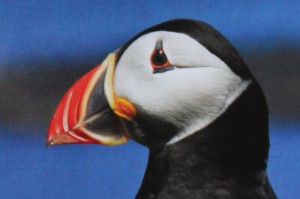 Puffins have been very much in the national headlines in the last year or so. This is not surprising as it is one of the, if not the, most iconic of seabirds. It made the headlines last year because when the vote came to select ten birds for consideration as our national bird the list included, to everyone’s surprise, the puffin. The birds were, in no particular order, barn owl, blackbird, blue tit, hen harrier, kingfisher, mute swan, puffin, red kite, wren and robin. The national vote was a huge success as far as numbers of people voting was concerned. However, nobody was surprised at the result as it was the robin that came in first followed by the barn owl and the blackbird. My own choice had been the wren but that came fourth whilst the puffin came last of the ten on the original list.
Puffins have been very much in the national headlines in the last year or so. This is not surprising as it is one of the, if not the, most iconic of seabirds. It made the headlines last year because when the vote came to select ten birds for consideration as our national bird the list included, to everyone’s surprise, the puffin. The birds were, in no particular order, barn owl, blackbird, blue tit, hen harrier, kingfisher, mute swan, puffin, red kite, wren and robin. The national vote was a huge success as far as numbers of people voting was concerned. However, nobody was surprised at the result as it was the robin that came in first followed by the barn owl and the blackbird. My own choice had been the wren but that came fourth whilst the puffin came last of the ten on the original list.
The latest factor to hit the headlines of the media is that the puffin is now under threat as their breeding numbers are plummeting. Although there are still very large numbers of breeding puffins in Europe there are very worrying downhill trends at several large colonies. There are a number of factors and a major one has been the massive decline in suitable fish stocks and, in particular, their favourite food the sand eel. Legal and illegal catching of sand eels continue unabated and oil spills have been contributing factors to the decline of the puffins. A major one has been the predation on puffins by brown rats on some island colonies. Eradication of brown rats have been carried out on some islands and has been very successful but at a very high cost indeed, running into hundreds of thousands of pounds. The latest attempt is under way at present on the Shiants but this is different as the culprits are not brown rats but black rats.
At one time puffins have been a major food source for man on some islands and perhaps the most famous of all was the archipelago of St. Kilda. There the puffin colonies are one of the many features and the St. Kildans once utilised them in very large numbers. They would treat a whole puffin as a snack and the birds were valuable not only for their meat but also their oil and their feathers. The colonies of puffins there are still quite dramatic to see and during my many visits in the past they were my favourite birds of the islands even before the great gannet colonies there. Ironically puffins are still eaten in small numbers in Iceland and can be found on hotel menus.
Puffins nest in burrows and will utilise those that rabbits have excavated. The end of the tunnel is lined with material such as grasses, leaves and feathers. The adults form a long term relationship and once the female has laid the large creamy egg both sexes share in the incubation. Both sexes will feed the chick which is called a “puffling” and the chick will fledge at night. The chicks spend their first few years at sea and return to breed about five years later. Adults will spend their whole winter at sea and will not return to land until the breeding season. Birds can now be seen heading north from such vantage points around Inverness at Tarbetness 50 miles north of Inverness, Chanonry Point on the Black Isle and Burghead just along the coast from Nairn. As shown in the photograph the beak is very colourful and dramatic but after the breeding season the coloured parts are shed, leaving a much smaller and duller beak.
Tags: highland birds
